Home
The Chiefs
The Isaac Family
Family Stories
Historical Accounts
Newspaper Articles
Photo Album
Yukon History
Traditional Territory
Language
Books and Reference
|
Culture and Religion
Clan
System
The
Han culture is based on two clans; Wolf and Crow. The children always
take their mother's side. If a mother is Crow all her children are
crows. If a mother is Wolf all her children are wolves. A person can
only marry a member of the opposite clan. No two Crows and no two
Wolves should marry each other. Crow has to marry Wolf and Wolf has to
marry Crow. A long time ago if a Crow married a Crow and a Wolf married
a Wolf this would bring bad luck to the Tribe and they would have to be
kicked out of the tribe and told to go far away. In the old days this
was considered law. The reason why they had this law was so people will
know who they are related to and that there would be no inner related
marriages. This is how everything was kept straight.
If a Crow dies, people of the Crow side would give a potlatch to feed
the opposite Wolf side and distribute gifts to them. The same holds
true if a Wolf dies, the Wolf clan will give the potlatch and gifts to
the Crows.
Long ago if a Crow woman was giving birth to a child, female helpers of
the Wolf clan would help deliver the baby. Then they would be paid with
gifts of moose skin and furs. The mother would say "Baby gives you a
present."
When this baby boy grows up to be about twelve years old, he will go
hunting with his maternal uncle to learn good hunting skills. The uncle
would be on the same side as the mother......Joy Isaac, Crow clan.
Clothing and Dress
Tradition Han Dress
As
did Northern Athapaskans, The Han dressed in tailored clothing of
skins, that of the caribou being the most important. Walter Ben was
confident that the Han never made garments either of fish skins or bird
skins with their feathers, or any kind of animal intestines.
Furthermore, they did not weave hats from spruce-root fibers.
Aboriginal dress was in most respects soon replaced by European-type
clothing, and consequently it is not surprising that descriptions of
items attributed directly to the Han are rare. As perhaps might be
expected, however, the longest comment on the Han Indians that was made
by Robert Campbell during the first trip through Han territory which
took place between June 5 and 10, 1851, was on dress. In his journal
for the same period, Campbell writes briefly about the Indians and one
can hardly doubt that they were Han. He says: "Their dress which when
new is pretty and picturesque, is made of the skin of moose or the
caribou, principally the latter. The shirt or coat is finished in a
point, both before and behind, and reaches down to to the knees, being
frequently ornamented with coloured beads, porcupine quills or long
hair. The coat has a hole large enough to admit the head, but does not
open in front, and is provided with a hood which can be used, when
wanted, as a head-dress. The trousers or leg covering, and shoes are
made of the same material, and the garment made with the hair inside
for warmth" (Campbell 1958: 97)
Alexander Hunter Murray, Hudson's Bay Company trader and founder
of Fort Yukon in 1847 provide the following drawing of neighbouring
Gwich’in dress.
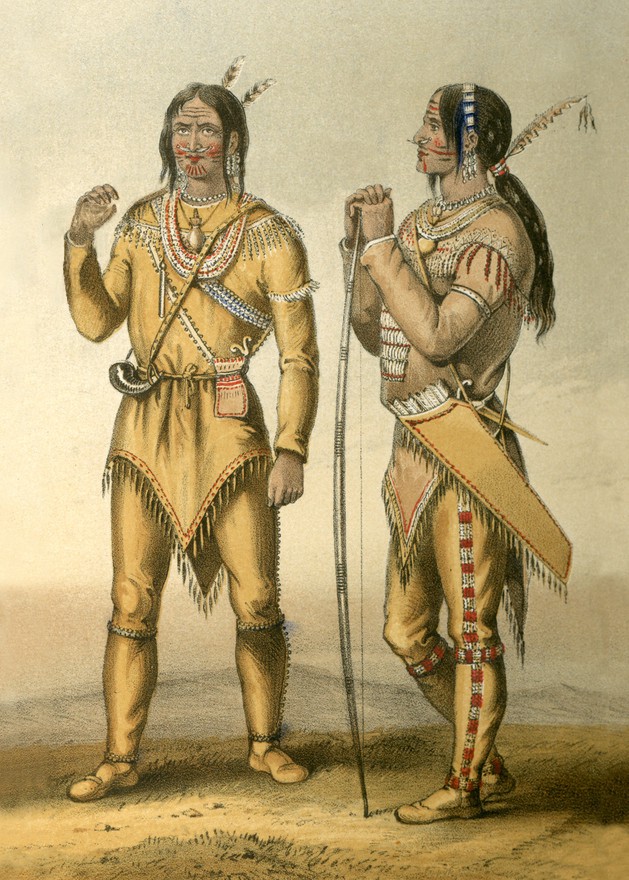 
Chief Isaac's Mittens
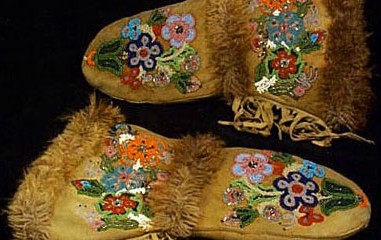
"Chief
Issac's mittens. The mitts are beautifully beaded in floral patterns, fur trim
and fringes. Originally they would have been beaded with the chief's name,
'CHIEF ISAAC', but the beading has since unraveled. They are impressive as they
are beautiful and elaborate. One can tell that they were made for a very
important and affluent person. Women prided themselves on making nice garments
for their loved ones and esteemed members of the community. Unfortunately the
seamstress who made these mittens remains unknown and there is no museum record
stating the maker's name. The mittens are beaded so elaborately, they may have
been made for special occasions instead of everyday use." - Photo and text provided by the Yukon Museums website. Chief Isaac's Jacket
Chief Isaac's Jacket
Photo Credit: Yukon Museums
"On June 30 1978 Marjorie Jeanne Duncan from Portland Oregon
wrote a letter to the "Tourist Information and Bureau of Indian
Affairs" describing a trip to Dawson in approximately 1926. She
explains how she, at that time was M. J. Beaver, and her grandmother,
Nellie E. Capper, traveled from Chicago to Dawson. The duration of
their stay in Dawson was about a week, during this time they met Chief
Isaac and his wife. The grandmother purchased a "buckskin beaded
jacket" of his. Mrs. Duncan believes that Chief Isaac and his wife
wanted her to have the jacket as well "out of friendship". Chief Isaac
autographed the jacket on the inside back.
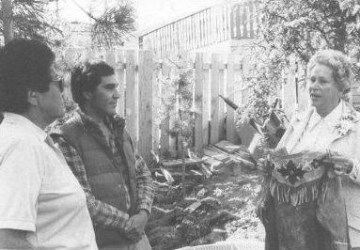
Angela Isaac, Gerald Isaac, Margori Duncan
| 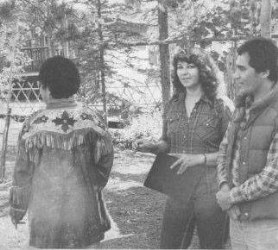
Angela Isaac, Joy Isaac, Gerald Isaac
|
Mrs. Duncan said that over the years many collectors have tried to buy
this from her, but she could never sell it because of the sentimental
attachment to her grandmother, their trip to the Yukon and Alaska, and
the friendship of Chief Isaac. At this time she wanted the jacket to
come back to the Dawson, to a museum or to a family member. The coat
eventually went to Joy McDiarmid (Isaac), and is currently on loan to
the Dawson City Museum."...See the Yukon Museums website for more
information.
At the Han Gathering held in Moosehide in 1994, Gerald Isaac made this
eloquent speech while wearing his grandfather's jacket:
I want to speak a little bit about this ceremonial jacket I'm wearing
today. This ceremonial jacket belongs to my grandfather Chief Isaac of
Moosehide. It has been brought back to my family some years ago. It
went away. It traveled all around the world. This "nogletstri" took it
as a gift from her grandmother that my grandfather gave to her.
And this jacket must be at least a hundred years old, and the last time
it was used was probably as long ago as maybe seventy years or more. So
it is with great honor and great respect and great pride that today I
display it to all of you. And I display it to all the First Nations.
and I display it to the public.
We are trying desperately to bring our Han culture back. We are trying
desperately, as you heard our elder Percy speak, to lay the ground
work, to bring our songs back, to learn our songs, to learn to play the
drum, to learn to sing and 'Ay-cha, hatr'unohthan, laa hozho chodza."
That means "to learn how to dance." And when we dance, we laugh, and
when we laugh we are happy. "Tr 'oahlay, ay cha. We are happy
also."
Yukon Indian News-1981-Commentary
Dear Indian people of the Yukon;
It was with pride and joy I read in the Yukon Indian News today that
Gerald Isaac presented to the Chief Isaac Memorial the ceremonial
jacket that Chief Isaac gave to my grandmother and me in 1927, when we
were in Dawson. We had come down the Yukon River on the paddlewheeler
Casca through the Five Finger Rapids. We stayed in Dawson where Chief
Isaac took us in his charge to escort us around to see Dawson and he
told us about his people, the community of Moosehide, and about his
family. Princess Pat and I are the same age, Princess Angela was a few
years younger. I never forgot the Chief's hospitality and sincerity.
The jacket went with me many places in the world. Many people wanted to
buy it and some wanted me to donate it to a museum and I said "no". I
told people that some day I would return it to the family and the place
it had come from, the Yukon. I had the pleasure of returning it in
1981, fifty four years after I had received it with my grandmother from
Chief Isaac.
An interesting thing happened when I came to Whitehorse and met Joy
McDiarmid (Isaac) and her family, she was the one I first corresponded
with about coming back to the Yukon. i met Gerald Isaac and his lovely
family. Angela Isaac Lopaschuk took me to town and said she wanted to
give me an Indian made gift and I declined. I said it would mean more
if she made the selection. She choose a pair of moccasins with the same
wild rose beaded motif that was on the coat, and she had not seen the
the coat as my son was bringing it up to meet me. The fur on the
moccasins was the same as the fur that had been down the front of the
jacket, but through the years was now gone.
I went to Dawson to meet Princess Pat and had a nice visit with her and
her son Barry's family also.
I read Joy McDiarmid's articles with great interest and about the
things Gerald is doing, as teaching surveying. Keep up the good work,
all of you.
Having made a reconnection with members of the Isaac family, I feel
friendship of my family and Chief Isac's family is a continuing
friendship. I read my copies of the Yukon Indian News that the Isaac
family have sent to me with great interest as does my son John Bonine
and his Canadian wife Anne, who also gets the paper. John teaches
Environmental Law at the University of Oregon and is interested in the
preservation of our United States and Canadian environments for the
good of all of us.
We wish you all well this year and in the years to come.
Sincerely,
Marjorie Jeanne Duncan
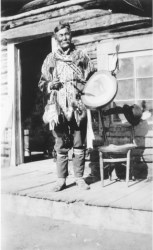
Photograph By Yukon Archives Anglican Church Diocese of Yukon
fonds89/42 # 746
Chief Isaac in transitional chiefly dress, wearing a chief's
jacket (made by his wife Eliza) and cloth pants. The jacket has an
abundance of leather fringe and flowered beadwork strip down the front
seams and across back shoulder. Beaded flowers are red roses and blue
forget me nots. His gauntlet-style mittens also appear to be heavily
beaded, and his bandoleer is the same one he wears while paddling a
canoe. One unusual feature is the decorative garters tied with ribbons
around his knees. Such garters were traditional among Natives living in
the southern part of the Yukon. His black bowler hat has been removed
and placed on a chair beside him.
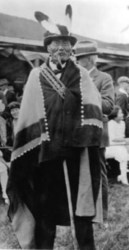
Photo Credit: Yukon Museums Chief Isaac, photographed in Dawson on August 15,1924,
illustrates
another striking blend of Indian and western dress styles. Here Isaac
sports a white shirt, dress suit, and bow tie under a wool
Tlingit-style button blanket. He has a bowler hat with two eagle
feathers sticking out, the beaded bandoleer draped over his shoulder,
and dentalium shell earings. The button blanket and the dentalium
shells(called ch'inthin in Han) probably came from the coast via
Tlingit traders. To complete the stylistic juxtaposition, Isaac's shoes
are laced leather with stiff soles, and in his left hand is a
half-smoked cigar. (HAN Han Hwech'in people of the river by Craig
Mishler and William E. Simeone)
Hunting and Gathering
Han
Hunters
In
1963, Han "Chief", Charlie Isaac make the following statement to a
visiting anthropologist about the training of young Han men before the
arrival of white man:
"The boys and young men were trained. Endurance, agility,speed and
sure-footedness were very important--important not only to the man but
sometimes to the whole tribe. A young man should not eat fish skin,
especially the skin of the King salmon, because it is slippery and
people thought it would make him slip when chasing caribou. They should
also not eat unborn calf of moose, caribou or sheep because it make
them heavy and make them get old soon. They must not sleep with their
legs stretched out, but always with legs bent. If someone in the lodge
notice a boy sleeping with legs straight, they would take a little
stick and hit his legs hard, until he curled them up. If he slept
stiff- legged, he would be stiff legged on snowshoes. When you are
running on snowshoes, especially in deep snow and uphill, you have to
be able to step high and bring your knees up in a good pace. Our people
were very good runners, famous for it. They beat the Loucheux (Kutchin)
in races.
Moose Hunting
Charlie Isaac gave Slobodin (1963a: 8-9) an account of
moose-hunting which is of special interest because it involves a
particular kind of geologic structure called a cirque--a deep,
steep-walled, amphitheatral recess in a mountain, caused by glacial
erosion. Charlie said of the fall season: This is about the hardest
time of year to hunt moose. Somebody would see moose sign in a creek.
The moose was deep in the brush and there wasn't much hope of getting
close to one. The men would go up the ridges to the head of the creek
and wait along the ridge in the curve of rocks (the cirque) above the
head of the stream.
The boys would start through the brush along the creek, making
a lot of noise. They were suppose to notice the landmarks at the head
of the creek: a clump of trees, a scar from a landslide, a big round
rock, maybe a patch of snow, and so on. Finally they came to the base
of the bowl (cirque). The hunters were hiding behind the ridge, and
couldn't see the moose climbing, but the boys would watch the moose and
would call out, "By the patch of trees!" "By the scar!" The men would
run along, bent over, behind the ridge. The moose would come up,
sometimes within six feet of the hunter, and he would be shot with
arrows.
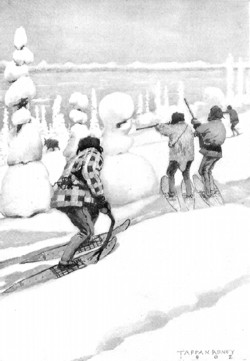
Moose Hunting
Source: The Indian
Hunter of the Far Northwest - On the Trail to the Klondike
Tappan Adney, OUTING, Vol. XXXIX, No.6, March, 1902
Salmon Fishing
Life of the Han along the Yukon
River in early 1900s
While the salmon are running in the river, the Han settle down
at their village at the mouth of the Klondike river which is situated
close to the water's edge, and do nothing but fish. The men make nets
and canoes and the women dry and cache large quantities of fish. In the
early fall the entire family goes hunting and gathering of berries and
roots. When a good supply of game is accumulated they cache it on the
spot. In October they return to the river for about two months, when
they make snow-shoes, toboggans, and other things for winter use. The
women tan moose and caribou hides and make clothing for the family.
About the middle of January they have a big time "all same Christmas"
when they get out all their cached meat and bring it to the river. They
stay there on the river until the meat is nearly gone, and again go in
search of game in February. In winter, extreme temperature changes can
make travel difficult as they hunt for caribou and moose. The men go
and when they get a moose or caribou the women come, pitch the camp,
and prepare to cook. In the spring they return to the river to prepare
for fishing.
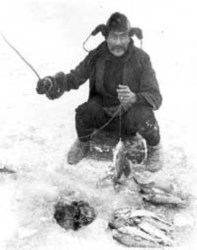
Chief Isaac ice fishing at the mouth of Klondike River
King Salmon run on the Yukon
River in 1920
The Kings enter the mouth of the river in Norton Sound early
in June,
and take about three to four weeks to make the first 1,250 miles to
Dawson, where the run is expected to begin about June 24. The date
varies from year to year.
South mouth of
Yukon----------------------------------------June 13
Marshall---------------------------------------------------------June 20
Paimiut-----------------------------------------------------------June
22
Kaltag------------------------------------------------------------June
24
Ruby--------------------------------------------------------------June
27
Tanana-----------------------------------------------------------June 28
Fish Creek, above Rampart Rapids------------------------July 3
Charlie Creek---------------------------------------------------July 12
Eagle-------------------------------------------------------------July
13
Dawson----------------------------------------------------------July 14
Caribou Hunting
Charlie Isaac gave Slobidin (1963a 7-8) this account.
Most caribou hunting was done in the mountains in the winter
time. The
people would be moving along, looking for caribou signs. Then they
might find some caribou tracks that might be one, two, three days
old--maybe weeks old. They would look around for the nearest open space
of clear ice, maybe an overflow or a glacier. Most of the people would
camp there. Five or six young men would be sent after the caribou. They
would take very little food -- maybe the people had very little food
anyway--and would follow the caribou two, three days, maybe a week.
Young men were trained to be good runners and to get along without much
grub. All this time they slept in the snow, didn't make a fire, kept
running all day.
Finally they caught up with the caribou, and then they got on
the other
side of them and turned them and began to herd them back toward the
camp. The first day, the caribou went fast, the next day slower; the
third day they were just walking along. Especially if there was deep
snow, it was hard for them. As they got closer to the camp, every night
one of the boys ran back to camp to give word how far away they were,
and then ran back to the caribou.
Finally they got close. All the people made a circle around
the clear
ice--old men, women, children, besides the regular hunters. Some had
bow and arrows, some spears, some knives. The young men drove the
caribou into the circle of people, and then the circle was closed and
all the people hollered and yelled: "Wow-wow-wow!" and kepted the
caribou running around in a tight-packed circle, around and around. The
kids yelled and waved sticks and hit the caribou's legs. The men used
the weapons. Usually they killed the whole bunch, maybe 35-40-50-60
caribou. Some would use just a knife. My father killed two caribou thay
way when he was young. You grab the caribou by an antler and pull its
head up. You have to watch its front legs. It tries to kick you with
its legs, and it could bust your chest in or kick out your guts. But
you stand to one side and hold the head away from you, driving your
knife into the side of its chest.
In 1915, Chief Isaac told a newspaper reporter: Dawson Daily
News
"Injun all return today from Glacier trail, where shoot caribou. All my
Injun shootum seventy caribou and bringem to Moosehide and putem in
cache for winter, Jess you tellem white man killem 3,000 caribou, but
Injun he killem only seventy. Me no likeum white man shootem caribou.
Jess you tellem in newspaper that it all right white man come dig deep,
catchem my gold on my creeks---that all right. Letem white man have
gold. Injun no eatem gold. But Injun wantem caribou ---wantem hunting
ground. In Alaska white man no huntem game; in Canada side whiteman he
go shootem caribou which belong Injun. Caribou my meat. I no shootem
horse. I no shootem whiteman cattle."
Sickness and Disease
The
notion common among the Athapaskans that sickness did not exist
aboriginally
Charlie Isaac expressed it when Slobodin (1963a; 20)
asked him "whether, whenever someone became ill, it was thought he had
been attacked by a medicine man." Charlie answered: "But people never
died of sickness in those days, only of old age, or accident, or
sometimes starvation--but not that so much because they usually got by.
The people were very strong. They run all the time, getting game, and
they had no liquor, no smoking."
"Disease is not always the result of the medicine-man's evil
spirit,
but sometimes comes on itself, so the Indians have certain medical
remedies. If they have a cough they chew grass roots or spruce bark to
stop the illness, and sometimes the old woman boil bark, roots, and
brush to make tea, which is drunk for all kinds of illness. Originally
many kinds of bark were boiled in the same mixture, making a brew for
the ailment."
Natural Plant Healing Sauve
I make this sauve from natural plants. Can be used for cuts,
scars,
insect bites, rashes, and arthritic joints. Can also be used as
mosquito repellant....Joy Isaac
Balsam
Yarrow
Poplar buds
Olive oil
Bees wax
Gathering: Gather plants in Spring in areas that are clean
from pollutants.
Drying: Spread plants on screen where air can circulate around
them. Let plants welt for 24 hours.
Oil Infusion: Chop the welted plants and place in a capped
jar. Add
enough olive oil to wet plants and a additional 1/2 inch. Cap jar
tightly, place in a thick brown paper bag, and place in sun for 3-10
days. Shake the mixture each day. When infusion is completed, strain
oil, press remaining pulp and filter out sediment. To this oil add
shaved bees wax. (standard practice is 1 oz. beeswax to 1 cup oil) Warm
this mixture over a low heat until the wax is melted. Remove from heat.
Cool down. Bottle; cap tightly; label; store in cool dark place.
Traditional Camp
Tappan Adney's Description of
a Traditional Camp Source: The
Han Indians-Cornelius Osgood
Tappan
Adney's experience in January 1898 provides an excellent description of
the portable skin dwelling used by the Klondike band of the Han.
Two
miles from the Yukon, above the mouth of the Bonanza Creek, the head of
the caravan stopped, and Isaac marked the place for the camp at the
edge of the river, alongside a dense grove of spruce-trees. As we
turned off the smooth miner's trail every person old enough to walk
slipped into snow-shoes, as the snow was about two feet deep.
The women
took long-handled wooden shovels and removed the snow off the ground an
elliptical space eighteen feet long by twelve feet wide, banking it all
around two feet high. While some covered the exposed river gravel with
green spruce boughs and kindled a fire in the centre, others cut sticks
three to five feet long and set them upright a foot apart in the bank
of snow, the long way of the intended house, leaving an opening at one
side two feet wide for the door.
The house-poles, an inch thick and ten
or twelve feet long, whittled out of spruce and previously bent and
seasoned into the form of a curve, were then set up in the snow at the
ends of the camp to the number of sixteen or twenty, their upper ens
pointing toward the middle in the form of a dome ten feet high. These
were strengthened by two arched cross-poles underneath, the ends of
which were lashed to the side-stakes with withes of willow twigs thawed
out and made pliant over the fire. Over this comparatively stiff
frame-work next was drawn a covering of caribou-skin, tanned with the
hair on, made in two sections, and shaped and sewed together to fit the
dome. The two sections, comprising forty skins, completely covered the
house, except in the middle, where a large hole was left for the smoke
to escape, and at the doorway, over which hung a piece of blanket.
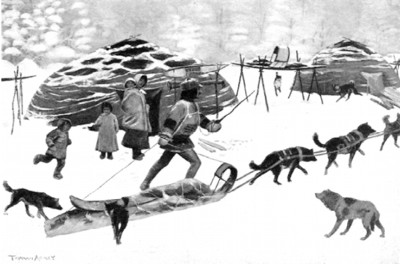
Traditional Camp
Source: The Indian
Hunter of the Far Northwest - On the Trail to the Klondike
Tappan Adney, OUTING, Vol. XXXIX, No.6, March, 1902
The
toboggans with the balance of the loads were hoisted upon pole
scaffolds each side of the house, out of reach of the dogs, who looked
and acted as if ready to devour anything from a moccasin to a rawhide
toboggan-lashing.
Not until the house was done and enough wood
stacked
before the door to last until morning did any one stop for a moment. In
a climate where the temperature remains not higher than thirty degrees
below zero, and occasionally drops to fifty or sixty below, it is
dangerous to dally, as white men are prone to do under the same
conditions.
In
our little village there were seven lodges. In the chief's house were
nine persons and seven dogs, divided into two households, each having a
side of the fire to itself. On ours were Isaac, his wife Eliza, with a
nursing boy less than a year old, myself, and three native
dogs--Chicken (child), Gagul (broken leg), and John: also a tawny
"whiteman's dog," Beaber, taken to board, a small black native pup, and
an extremely miserable short-haired white man's pup, wrapped in a
blanket to keep from freezing, and weighing just fourteen pounds by
Isaac's spring scale. On the other side were a middle aged, stocky
built man known as "Billy", or "the missionary's man," and his wife,
with two girls respectively about eight and ten years of age, and a boy
of the same uncertain age, four large native dogs and two pups. The
human occupants kneeled or reclined before the fire, which was
ingeniously built to throw the heat in two directions and to draw well,
notwithstanding which latter, I soon discovered that it was often
necessary to lie close to the ground, and when the smoke became too
thick, to lift the lower edge of the skin covering.
The
following morning before daybreak word was given "All go." Toboggans
were rattled off of caches, and house taken down and loaded as swiftly
as they had been set up.
The
Potlatch
The Tr'ondek Hewch'in, or Klondike band of Han, came under
intense
pressure to change during the Klondike gold rush. One change desired by
the Canadian Government was abolition of the potlatch. In 1884,
government amended the Indian Act, making participation in the potlatch
a misdemeanor.
Responding to this prohibition, Chief Isaac of Moosehide "took" many of
the Han songs and dances associated with the potlatch and left them
with the descentants of relatives and friends who now live in the
village of Northway, Tetlin, Tanacross, and Dot Lake. According to
stories told by residents of Tanacross, Dot Lake, Tetlin, and Dawson,
Chief Isaac gave the songs, dances, and a dance stick called a
"ganhook" or "ganho" to the people of the upper Tanana region. These
songs have been retained in people's memories until today, and some of
them are still actively performed.
The "ganhook" or "ganho" is a dance stick used by the lead dancer to
direct the movement of the other dancers. Ganhooks today are made from
flat boards about six or seven feet long and five or six inches wide
that have a handle at one end and hole in the board for the thumb. They
are painted various colours and decorated with ribbons, yarns, and
beads.
Chief Isaac attended a memorial potlatch for Chief David of Tetlin
about 1917. At that potlatch Chief Isaac taught the Tetlin people Han
songs and gave them drums and a ganhook.
Tanacross elders say that the Han from Dawson were noted dancers who
taught their dances to relatives from Mansfield Village. Tanacross
tradition also says that in 1912 Chief Isaac of Dawson left the ganhook
at the old village of Lake Mansfield. Gaither Paul of Tanacross
described it this way: "They dress and they came into Mansfield. They
comin' up there, and when they comin' over the hill I remember people
say they come over just like spruce hen. You know they dance like that,
they comin' over just like that, just like spruce hen comin' over.
Their leader is the only one standing up and behind him is just like a
bunch of spruce hens. That was part of the dance. They used to dance
that way. They don't dance like that any more, like spruce hen.
That is probably 1912, they said. That is the year that ganho come to
Mansfield. That Moosehide chief brought it up and he left it, he
brought it up, and he come ahead with it. Ganho come from Dawson
people, started that.
I don't know the meaning, too. I hear that Moosehide chief left that at
Mansfield as a gift when he came. And he left it there without it, to
be used in dance. That is the start of ganho in dance. Moosehide chief
brought it in.
I don't know the original one, what happened to it, but I saw it. It
was painted really beautiful, beads or yarn hanging down and when you
shake it, it kind of rattle, that is what he carried ahead. He left
that with Mansfield people. That is the start of use of ganho in
Tanacross area. That is what I heard, my father told me this. Just like
the chief at Dawson left that as a gift at Mansfield when he came that
year. From there they copy it and always use it in dance."
(Source from HAN people of the river- Craig Mishler, William E. Simone)
Potlatches at Moosehide
By Auntie Pat
Interviewed by Julie Cruikshank, December, 1974
In the old days, people make lots of potlatches. Other tribes have
their own chiefs too. Sometimes they get together, have potlatch. These
chiefs, they meet, make big speech.
To give potlatch means people are related. It happens at death. Indians
are like that. When there is death, Indians get great sorrow. They make
up sad songs. They mourn. They dance in circles, move their arms up and
down. They make presents to each other, Crows and Wolves. If Crow dies,
Crows give potlatch and they give presents to Wolves.
Potlatch can last one week or two weeks. Them days, men make money
trapping. They potlatch with rifles, calico, Hudson Bay blankets-thats
the most important. They make duffel out of those blankets, line parky,
underwear, inside mitts. Sometimes they give money too - $50 or $60.
Those days groceries cheaper, so potlatches last longer. Eat dry fish,
moosemeat, soup.
I've seen several potlatches, all at Moosehide. After old people died,
no more potlatches, just dinners and dances. People used to have lots
of respect for each other those days.
At burial, dress that person up with new clothes. Cover up with Hudson
Bay blanket. Minister stop all that. I don't know why.
No grave houses our way. At Pelly, Ross River, Little Salmon, they have
grave houses. Put in frying pan, plates, whatever that person use. Down
our way people don't do that. They make fences, all kinds, all white.
Now, no more.
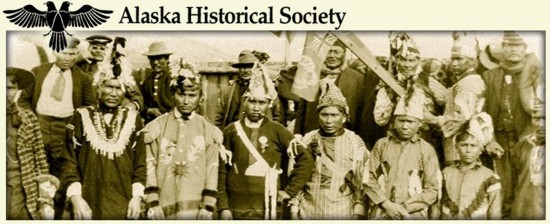
Photo from Alaska Historical Society website: Potlatch at Mooside, July
4, 1907: Eagle Dancers: Paul Peter, Ken Joseph, Old Alex, Charles
Steve, Edward Jonathan, Esau Harper holds potlatch stick, Chief Isaac,
David Rabit. Courtesy of Eagle Historical Society.
1910 Potlatch at Eagle, Alaska
Last winter the Eagle chief died. He had hoarded up much wealth of
skins, blankets, traps, rifles, and other property and, since it is not
customary among the Eagle Indians for relatives to inherit the property
of the deceased, his kinfolk received nothing of his belongings. By
common consent Old Peter took charge of the effects. It was then
announced that there would be a "potlatch" in the spring, when the
goods of the deceased man would be given away. Invitations were sent
east to the Moosehide Indians up the river, west to Charlie Creek
Indians down the river, and south over the hills to Ketchumstock
Indians. The Porcupine Indians (Takkuth Kutchin) to the north were not
invited, because they were not related to the tribe. All the goods were
kepted intact in the caches until the arrival of the guests. Then Chief
Isaac, the Moosehide chief, took full charge of the ceremonies, which
lasted several days, during which there was much feasting and dancing.
At the dinners, the men first gorged themselves, allowing the women to
come in after they had finished and take what was left. Between the
ceremonies they assembled in groups about the village and gossiped or
sung to tunes resembling those of Japanese operas. Tune was kept by one
of the Indians beating upon a caribou-skin drum, while everyone swayed
to the tune, alternately bending the right and left knee. For the final
ceremony a fence about seven feet high was built about an enclosure
thirty by sixty feet. The "potlatch" proper was held in this enclosure
during one afternoon, the people sat about near the fence facing the
goods of the deceased, which were displayed at one end by Chief Isaac,
who stood in the midst and presided. The first hour of the ceremony was
very mch like a church meeting, all talking in their native language.
The chief then opened with a speech, and when he sat down others rose
and spoke as the spirit seemed to move them, apparently eulogizing the
great chief. At times the speaker became much wrought up, his gestures
showing that he was illustrating a fight with an animal. After the
speech making, the goods were distributed one article at a time. The
chief would pick up a blanket, walk down the center of the assembly,
and with a few remarks toss it to someone, the recipient smiling
responding with brief remarks. Articles were only given to the
visitors; the Eagle Indians received nothing.
After watching the ceremony several hours, I was about to leave when
the chief called me and handed me a pair of moose-skin moccasins,
saying, "This is because you were good to my people." Next day the food
became scarce, so the visitors began to depart for their homes, their
toboggans laden with goods from the deceased chief's cache. (Source,
Ferdinard Schmitter, 1910 Upper Native Customs and Folk-lore)
Religion
Chief Isaac had a special relationship with both Bishop Bompas
and Bompas's successor, Isaac O. Stringer. In 1918, Chief Isaac was
surprised and pleased to learn that Mrs. Bompas had bequeathed him her
husband's watch. Ten years later, during an Anglican Synod, Chief Isaac
presented Bishop Stringer with his grandfather's stone hunting knife.
Source: HAMMERSTONES, A History of the Tr'ondek Hwech'in by Helen
Dobrowolsky
Moosehide Village - Christmas Celebrations in 1924
Source: Dawson Weekly News-Friday, January 11, 1924
Moosehide, the colourful home of the Montezumas of the
Klondike, was
the scene of picturesque and dramatic performances last evening, or,
rather, last night, as the show throughout the period usually alloted
to sleep to place.
Chief Isaac, the grand sachem of the Moosehide tribe, and his
braves
and belles, comprising the real blood and sinew of Yukon's first
peoples, gave their white friends a grand welcome and put on for their
delectation numerous historic tribal performances.
The urge to visit Moosehide last night was the annual
Christmas Tree
party of the tribe. In order not to conflict with the holidays of their
white friends in Dawson, the Moosehide people deferred their tree until
after the usual Yuletide and New Year functions were concluded within
the heart of the gold metropolis. But when the Moosehide celebration
did come it made one worth writing home about.
Rev. Benjamin Totty, the Anglican missionary at Moosehide, and
Mrs.
Totty, daughter of the most famous of Yukon's pioneers, the late
Captain Al Mayo, were in charge of the Christmas tree functions, and
entertained a number of their friends from Dawson at supper prior to
the tree, and served refreshments again later in the evening. Bishop
and Mrs. Stringer headed the party of visitors, about fifteen of whom
went down in a large police sleigh drawn by four horses, and supplied
through the courtesy of Captain Richard Field, acting Commander of the
RCMP in Yukon, and Mrs. Field, who went along in charge during the ride
and lent much life and spirit to the evening.
The Christmas tree was held in the old building which was
erected in
1897, by the late Bishop Bompass, and still renders good service. The
tree was brilliant with all sorts of gay decorations, candles and gifts.
After brief preliminary remarks by Bishop Stringer and Rev.
Totty, the
Indians sang several Christmas carols in English and the native Takudth
tongue. They proved splendid singers and showed that they had been well
trained and have good voices and musical talent.
The distributions of gifts then took place. The little hall
was crowded
with natives and the white visitors, and the faces of every little
child and elder members of the Moosehides beamed with delight as Santa
Claus came bounding through the door, clad in his bright red suit, with
snowy beard. He was the most versatile and agile Santa Claus that ever
came over the trail. When he entered he apparently was very tired, but
as the gifts started to come from the tree and he personally delivered
them, he warmed up, and soon was 100 percent thawed out, and then the
fun began. Santa did the alaman all by himself, danced a grotesque step
all his own, cake-walked, gyrated, sidestepped and clogged up and down
the little room, and had a handshake and a word for everyone receiving
a gift.
When finally a little box of candy came to Santa himself, he
became
fairly delirious for a few minutes, and executed a fantastic tribal
dance. Then the gift making went on, and after that brief addresses,
story telling, and songs made up and informal program. Those speaking
and expressing their facilitations over the happy gathering included
Bishop Stringer, Constable Lindesay J. Brian, Chief Isaac, Sam Smith,
and others. Mrs. Stringer told a delightful story of how the Eskimos
observed their first Christmas celebration at Herschel Island, when
there was not a tree within 100 miles and they had to make a tree of
poles and barrel hoops, and how she, herself, was the "First Santa"
there, as the men folks were in charge of the program and there was no
other white person in the region who could assume the role.
"Santa Claus" then was called upon, and he sang a Christmas
carol, and
concluded by leading the singing of "Happy Day", in the Indian tongue,
and accompanied the vocal efforts with such original contortions that
he put any college yell leader to shame. This Santa was none other than
"Happy Jack" of the Moosehides, and he danced, jigged, and threw
himself in such fantastic fashion as he led in the wild song that cheer
after cheer greeted him. The other Indians joined with him, and when
the singing was concluded the visitors declared they had discovered the
origin of the college yell.
After that the whites all sang "Good night, Ladies", and a
farewell to
the native hosts and entertainers, and concluded with a verse, "Good
night, Santa Claus", and, as the last vibrant notes died away, Santa
gracefully backed out the door, and was gone.
The next big event then was the dancing in Johnathon Wood's
cabin, a
large place. By that time about fifty more white friends of the Indians
arrived from Dawson, and the seats about the wall were crowded. Chief
Isaac, master of ceremonies, arrayed in gorgeous beaded coat, as
designed by his wife, announced that the young men of the tribe would
dance as did their fathers 2,000 years ago, in war dances and
celebrations. Five young members of the tribe came in, gorgeously
arrayed in fantastic costumes, and did many strange and weird dances,
including the Moosehide dance, the Ross River dance, the Coffee Creek
dance, the MacKenzie River dance, the Selkirk dance, the Tanana dance,
the Eagle dance, the duck dance, the caribou dance, the fish dance, and
others. The singing was incessant while the men danced, and some of the
young ladies from town were momentarily alarmed when the braves leaped
near them, but it was all over in a second. More agile dancers never
were seen, and they were at times prone on the floor, and at others
cutting circles in the air. The Indian dancers were: Jimmy Wood, John
Titus, Alfred Titus, Stanley Roberts, and Charlie Isaac son of the
chief.
After that Mrs. Stringer requested to sing a song in "Husky",
the
Eskimo. She said she could not sing, but would show how the Huskies
danced. They always danced in pairs and the women keep their feet on
the floor, while the men leaped as high as possible. For this reason it
was necessary for the Bishop to assist in the demonstration, and there
was great merriment as Mrs. Stringer moved swiftly about the floor
without raising her feet, and the Bishop beat a pom pom, and stepped as
high, wide and handsome as he could. After that Jimmy Wood and Mrs.
Smith and others demonstrated the jig dance, a continuous performance,
and several others demonstrated the jig dance, a continuous
performance, and several others special steps concluded the special
dances of the evening. The Indians then took over the dances, and fox
trots, square dances and waltzes were the order until 3:00 in the
morning. Most of the white visitors left at 10:30 p.m.
"Santa Claus all gone now" said the Chief. "No come back till
next
year. He was pretty good. He know in this country I own all things,
gold, silver, fish, meat, and fur. I own all Mayo and Keno Hill. Any my
father own it before me."
|
|
Burials In old
days our people were buried up in Moosehide Cemetery with
their feet pointing up the hill and head down towards the Yukon river
as our people believed that their dearly departed loved ones would
"walk up away to happy hunting grounds". My mother Angela told me
this....Joy Isaac
|
|
Reincarnations Many
cultures have myths and legends on reincarnations and
believe that when someone dies they reappear not as their former selves
but as a spirit or soul in other people. My uncle Charlie Isaac
believed in this and when he first saw my first born daughter Bonnie,
he shook her little hand and said "Hello Mom, Hello Mom". He then said
"My mother Eliza came back, you should have named her Eliza." Little
Bonnie has my grandmother's spirit. (My Shetso Eliza).. Joy Isaac
|
Medicine Man
Slobodin (1963a:19) Charlie Isaac states: "The medicine man knew all
kinds of plants for curing and also could do doctoring. If somebody
broke an arm or leg, he could set it, then wrap it in fresh birchbark.
The birchbark would dry hard and be like a cast; stronger than a cast.
They used spruce gum for a salve and also for chewing and made tea from
different plants for curing." |
|




